If you asked most people what color egg yolks are, they would likely answer yellow.
Yolks have always been associated with the color yellow, which is unfortunate because backyard chicken keepers know better.
Backyard chicken keepers know that yolks can—and should—be a bright, bold orange, and those bright, bold orange yolks are a sign of happy, healthy hens.
In an unscientific home experiment, I compared my pasture-foraging, insect-pecking, soil-scratching, whole grain-feeding chickens’ yolks to the yolks of both their “free-ranging” and factory-farmed counterparts.
The results were clearly visible: Yolks from my homegrown eggs were not only darker, but also fuller and thicker. Even the eggshells were denser and harder to crack.
But what’s the big deal about orange yolks?
Turns out that besides being a coveted color, orange yolks can be an indication of a well balanced and highly nutritious diet.
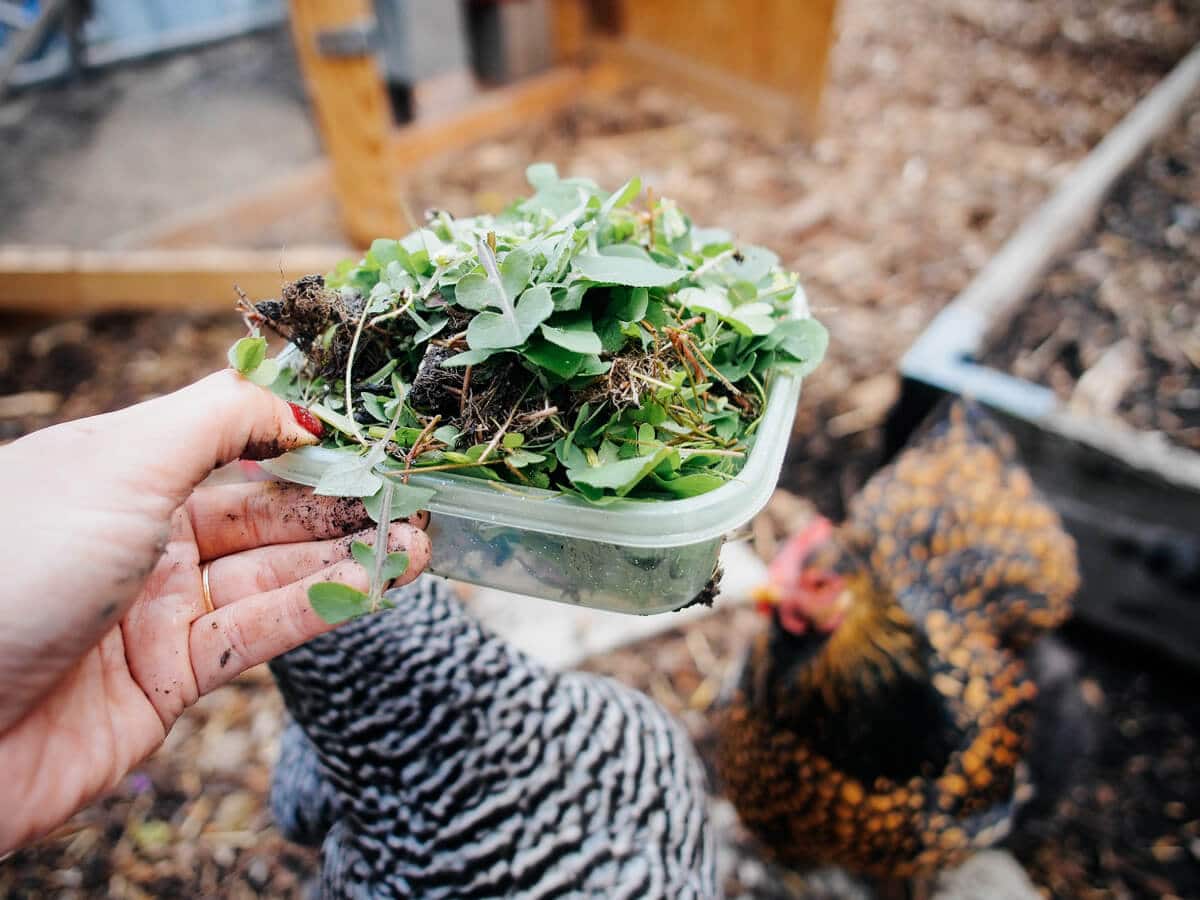
What makes egg yolks orange?
A few things factor into the making of an orange yolk: xanthophylls, omega-3 fatty acids, and meats.
Xanthophylls
The chemicals responsible for yolk coloring were first documented in 1915 in the Journal of Biological Chemistry.
Dr. Leroy Palmer wrote that “The consumer demands highly colored yolks in ‘fancy’ eggs throughout the year, and the eggs with pale colored yolks, so frequently found on the market during the winter months, are the object of much complaint, particularly in cities.”
He determined that orange yolks were produced by a class of carotenoids called xanthophylls, and over 100 years later, this conclusion is still widely accepted.
Carotenoids are natural plant pigments found in many fruits and vegetables. It’s often thought that beta-carotene, one of the more well-known carotenoids, is responsible for giving yolks the orange pigment that people associate with carrots.
But in actuality, beta-carotene benefits yolks nutritionally, rather than pigment-wise.
Read More: Propaganda Told Us Carrots Can Improve Eyesight—Here’s the Truth
The carotenoids that cause deeper yolk coloring are xanthophylls, which are more readily absorbed in the yolks. (Lutein is one such xanthophyll, and a lot of lutein means a lot more orange.)
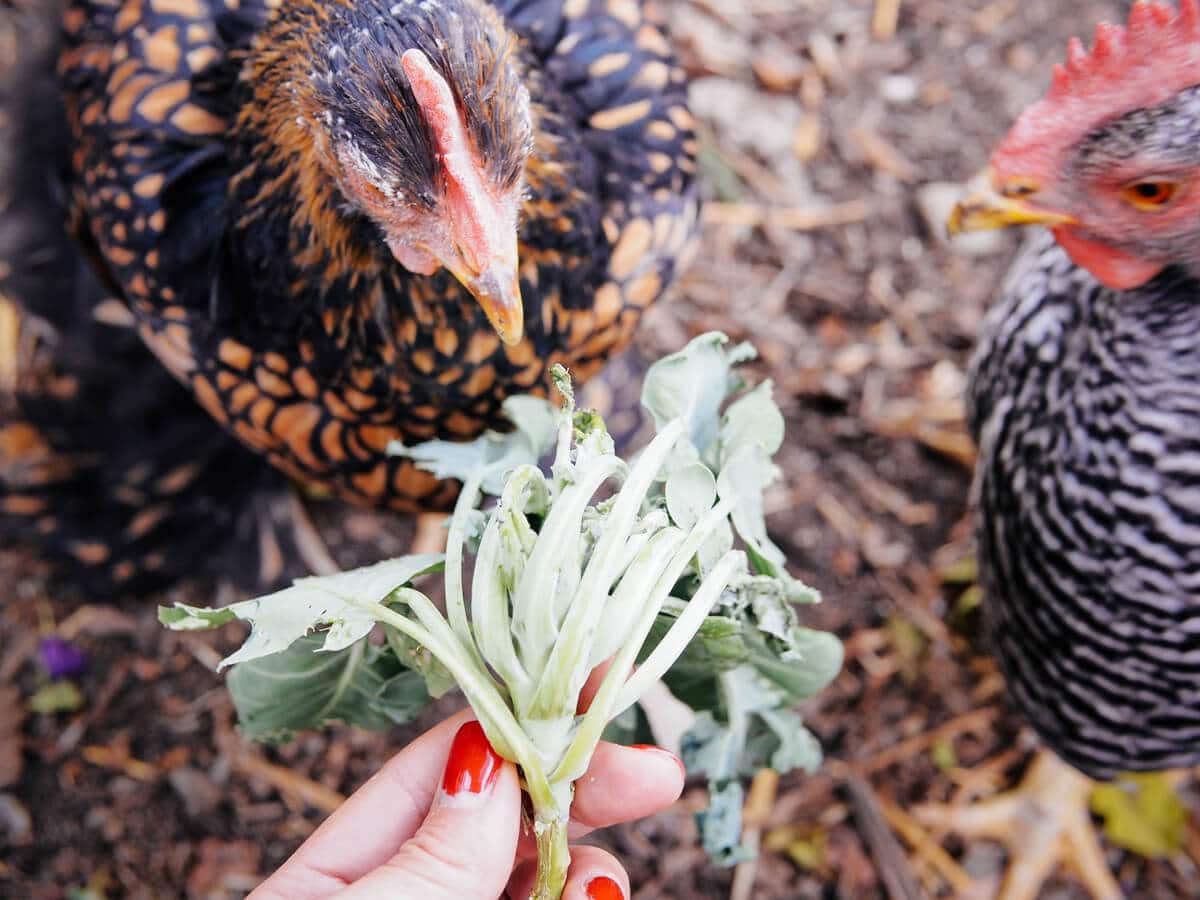
Xanthophylls are found in dark leafy greens like spinach, kale, and collards, as well as in zucchini, broccoli, and brussels sprouts.
(I know it seems weird that a carotenoid that turns egg yolks orange is found in green vegetables, but stay with me here.)
Related: Why Purple Beans Turn Green After Cooking (A Kitchen Magic Trick!)
Omega-3 fatty acids
Omega-3 fatty acids are highly concentrated in oily fish (especially cold-water fish like salmon, tuna, and mackerel), shellfish, algae, tofu, and high-fat plant foods (like brusssels sprouts, navy beans, and avocados).
They’re also found in flax seeds and sea kelp, which are both important components of my homemade whole-grain chicken feed.
Meat
Did you know that chickens are not meant to be vegetarian, no matter what your premium carton of organic/grain-fed/cage-free eggs tells you?
Chickens are omnivores by nature and their healthiest diets include meats, such as mealworms, beetles, grasshoppers, grubs, and whatever creepy-crawly they can pull out of the ground. I’ve even heard of chickens attacking and feeding on small rodents and snakes!
And yes, you can even feed your chickens the leftover cooked chicken from last night’s dinner (no matter how wrong that may sound). It’s good for them, and won’t turn them cannibalistic.

Are dark orange yolks healthier for you?
Yes and no.
You see, color alone has very little to do with the nutritional content of an egg yolk. Yolk color depends almost entirely on the pigments found in the food that chickens eat.
When hens eat a diet that’s heavy in yellow corn, they lay eggs with medium-yellow yolks. A diet of wheat or barley results in eggs with lighter-colored yolks, and a colorless diet (such as white corn) produces nearly white yolks.
In fact, it’s so easy to “dye” the color of a yolk that a Santa Fe, New Mexico farmer, Matt Romero, is known for his legendary flame-colored egg yolks, which he gets simply by feeding his hens the leftover red chile peppers from his farm.
Other farmers “hack” their way to darker yolks by feeding their flocks marigold petals (which produces deep yellow yolks) or even using synthetic chemicals like Rovimix Carophyll Yellow, Canthaxanthin, Xanthophyll B, and Lucantin Red to achieve the dark yolks they think their consumers prefer.
This is why you should be leery of cheap eggs from the supermarket whose yolks come out orange.
On the flip side, there’s cause for concern if store-bought “free range” or “pastured” eggs have very pale yolks. It could mean the egg producer is only giving the hens minimal access to the outdoors, like a single door out to a patch of grass.
Foods That Naturally Impact Egg Yolk Color
| Yolk Color | Ingredients |
|---|---|
| Nearly colorless | White cornmeal |
| Light yellow | Wheat, barley |
| Medium yellow | Yellow cornmeal, alfalfa meal |
| Dark yellow | Marigolds, leafy greens, alfalfa |
| Orange to red | Pumpkins, tomatoes, red peppers |
But, there’s a big but to all this…
Chickens whose diets are rich in leafy greens, flowers, seeds, weeds, and meat lay eggs with naturally darker yolks. The xanthophylls, omega-3 fatty acids, vitamins, and minerals in these food sources are then passed on to their eggs and concentrated in their yolks.
Research has shown that of all the nutrition found in eggs, most of it is found in egg yolks, including fat-soluble vitamins like D, E, K, and A (none of which you get from egg whites), essential fatty acids like DHA and ALA, and other nutrients like calcium, iron, magnesium, zinc, choline, and B vitamins.
According to Mother Earth News, which conducted its own egg analysis, and a more recent Pennsylvania State University study, pastured eggs (where hens are given free range with ample access to greens and bugs) contain higher levels of vitamins A, D, and E, more beta-carotene, and more omega-3s than eggs from caged chickens fed primarily grain.
All this means is that a pastured egg (ideally from your own yard) is healthier for you. And that’s one of the reasons we raise chickens, right?

How to get dark orange yolks from your chickens
1. Let your chickens free-range.
Let your ladies roam a pasture (or a garden—especially if you’re digging over soil—or even just a new patch of dirt in their chicken tractor) for an orange-boosting bug buffet. They like to scratch through leaf piles and layers of mulch where protein-rich grubs and tasty earwigs often hide.
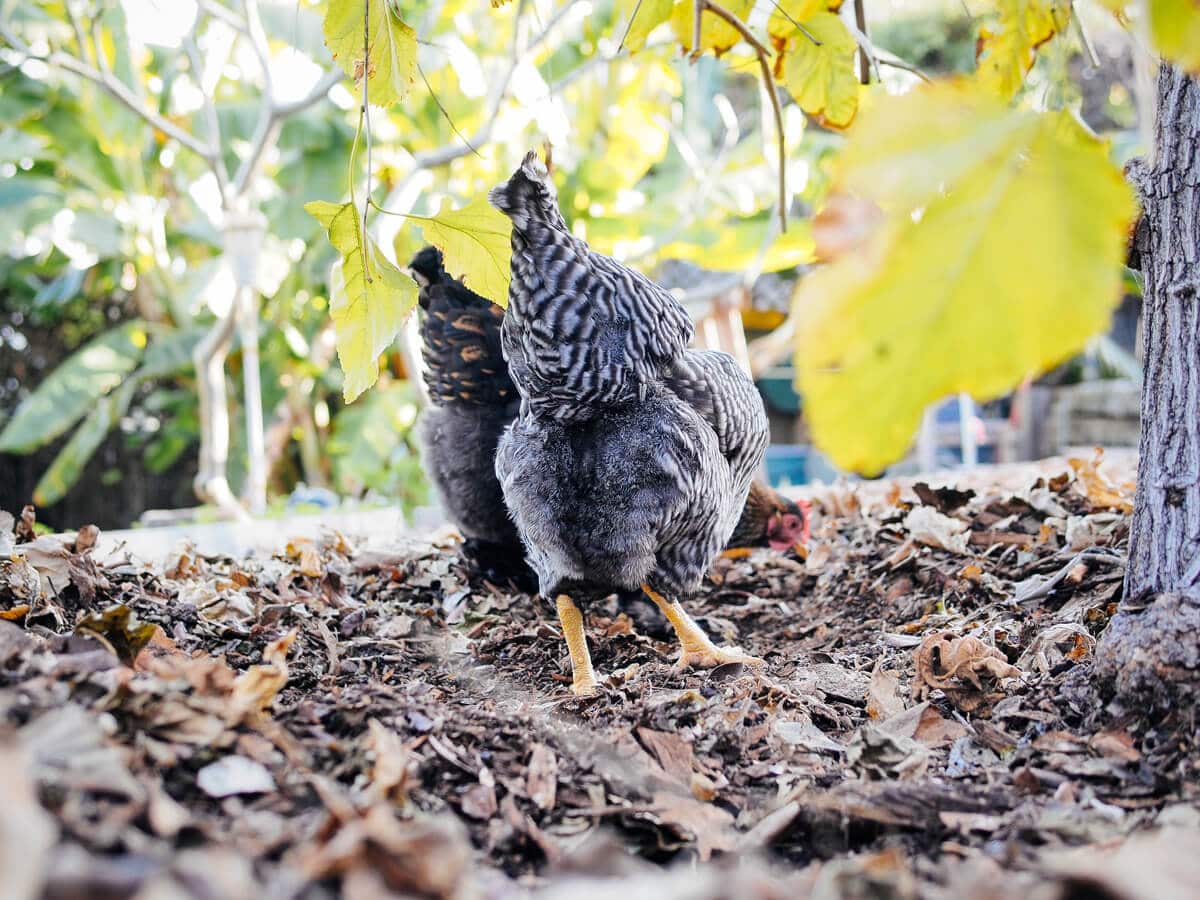
If it’s recently rained, let your chickens out so they can hunt for worms, sowbugs, slugs, centipedes, and other bugs that emerge when things get more damp.
Pastures (or backyards) full of rich grasses, ground covers, and cover crops are a wonderland for your flock, giving them plenty of opportunity for forage and exercise.
2. Feed your chickens lots of leafy greens.
Give your chickens plenty of fresh greens to increase the lutein in their yolks.
The darker the green the better, so I often fix them a feast of edible amaranth (one of my favorite summer greens), kale, mustard greens, broccoli leaves, or whatever I happen to have growing in my garden.
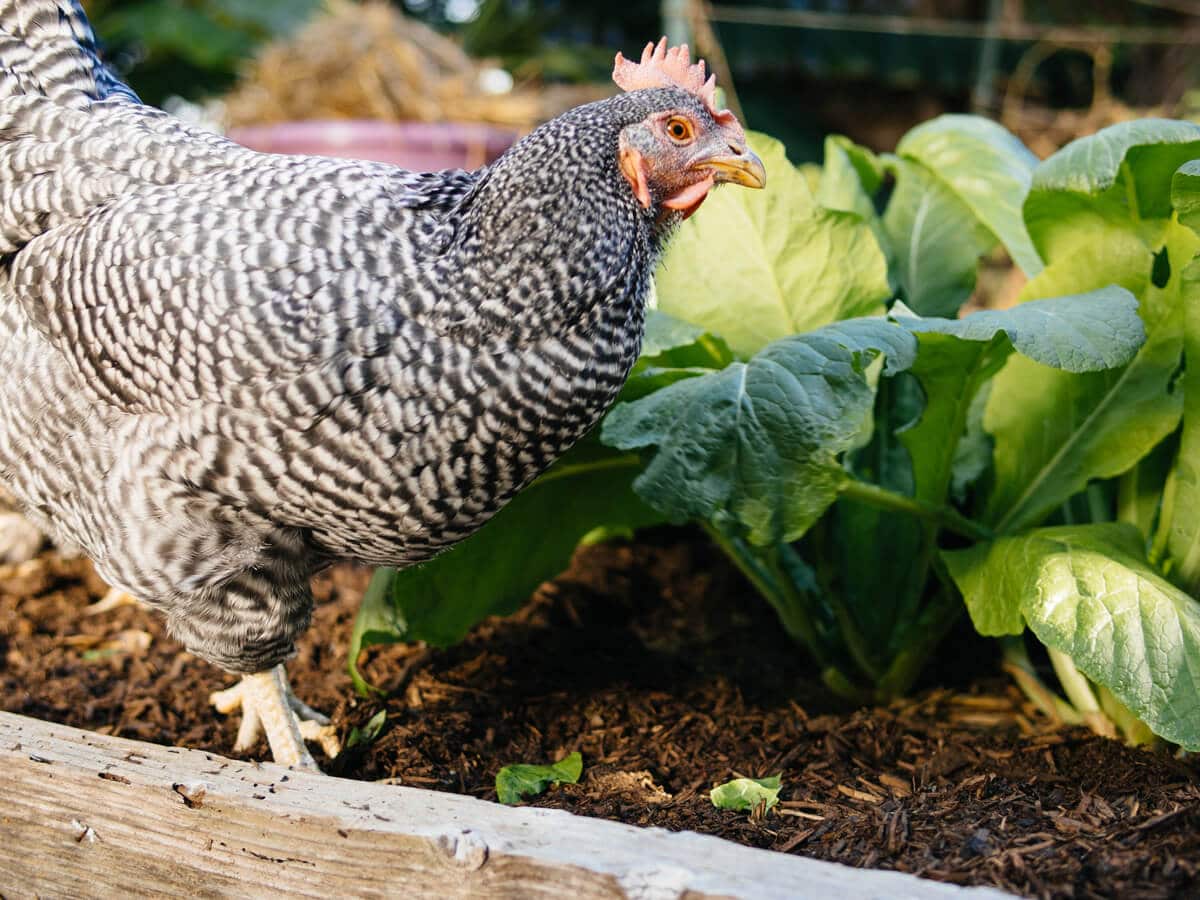
If it’s the middle of winter and your garden greens are lacking, you can give them alfalfa for a nutritional boost.
3. Let the chickens weed the garden for you.
Rather than pulling all those (vitamin rich!) weeds out of your garden, let your chickens do the dirty work! They love to forage for dandelions, mallow, clover, oxalis, chickweed, purslane, and other plants that sometimes grow where they shouldn’t.
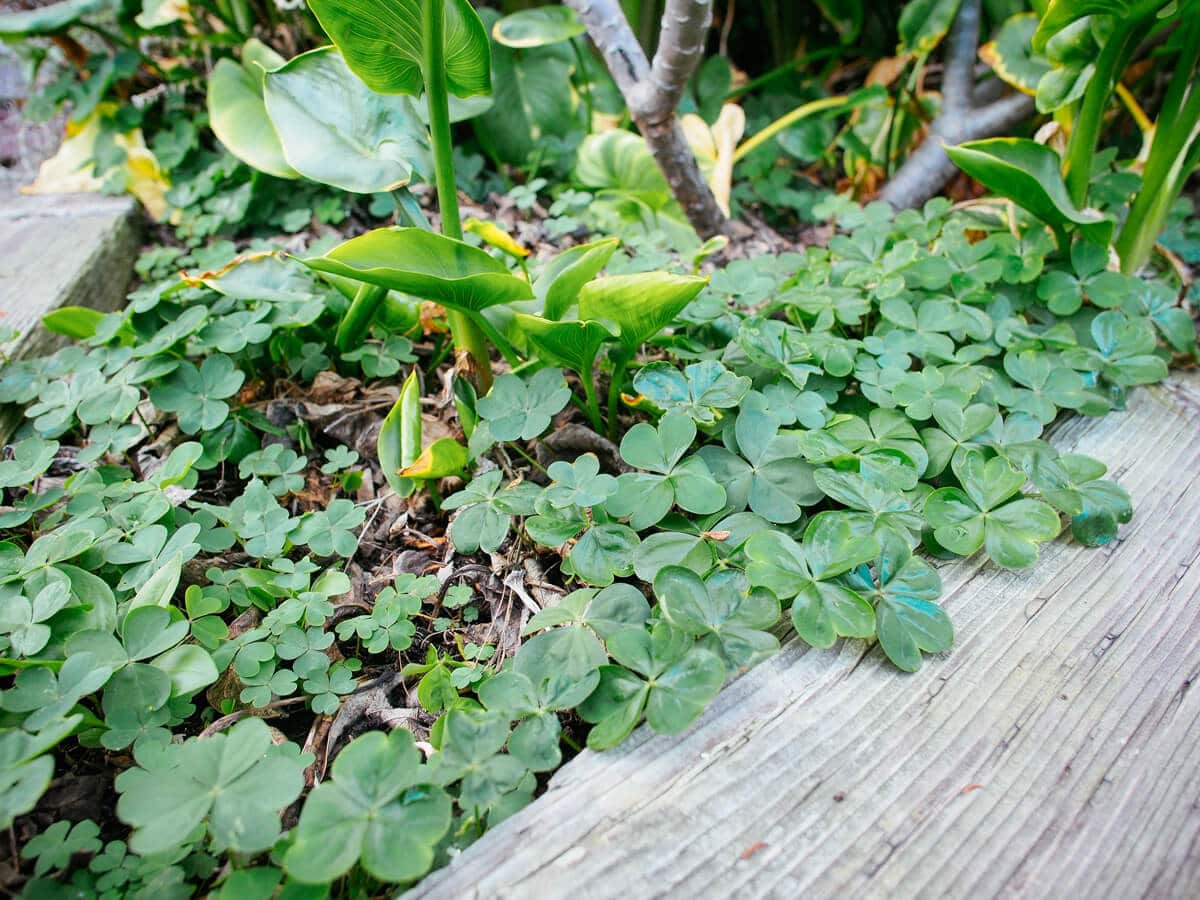
In fact, these types of weeds can be cultivated in a landscape especially for your flock, as they’re low-maintenance and make a lovely, natural, and “wild” lawn that benefits other wildlife as well.
Learn more: Best Edible Ground Covers for Vegetable Gardens
4. Enlist your chickens in yard clean-up.
Chickens are very handy helpers at the end of the season when most of your plants have bolted and become aphid-ridden.
Let the chickens clean up those plants before you toss them into the compost. It’s a win for everybody! (Except the bugs, that is…)
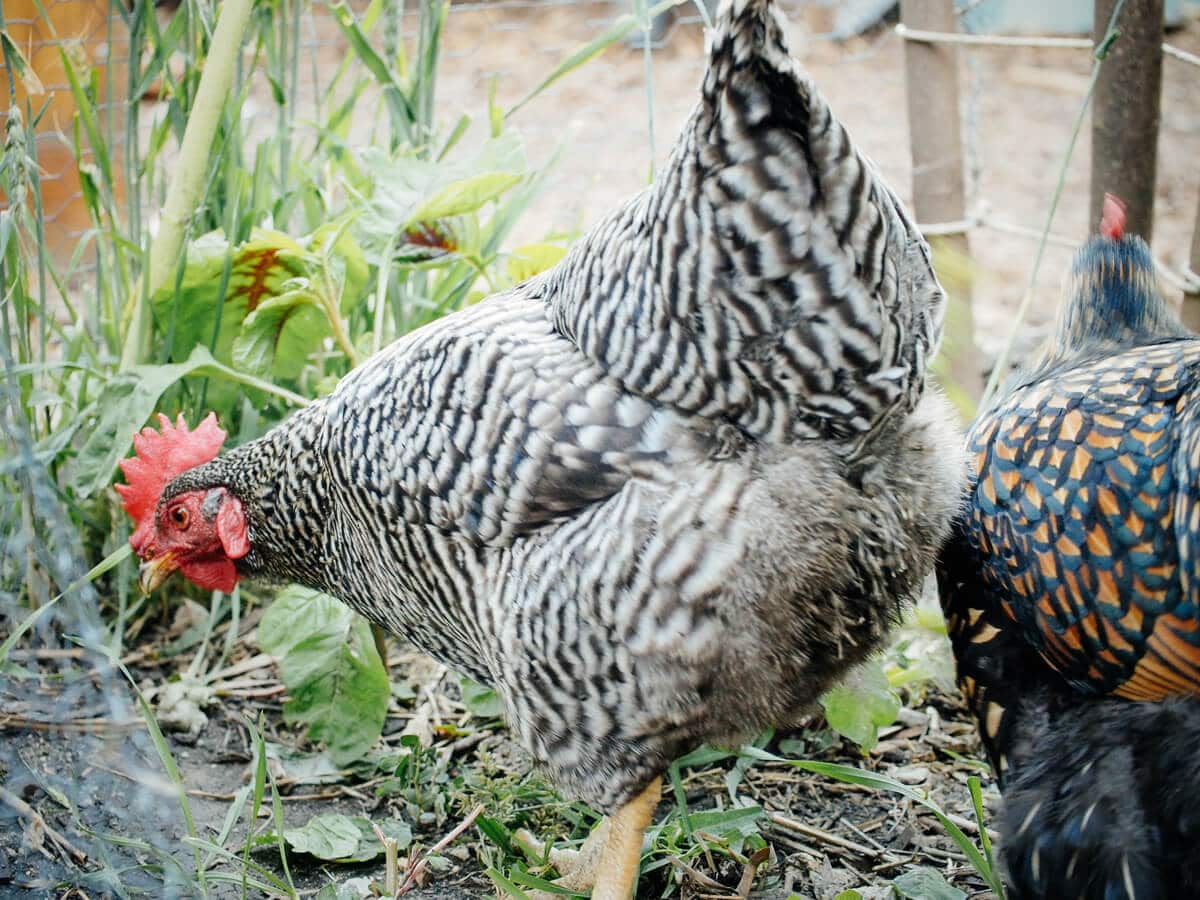
Not only will they take care of the pests on your spent plants, they’ll eat whatever’s left on the stems, including flowers and seeds.
5. Let your chickens turn the compost pile.
If you have an open compost pile, chickens do good work of turning over yard debris and kitchen scraps as they scratch and peck for grubs and worms. (Black soldier fly larvae, which are commonly found in decaying organic matter, have even more protein than mealworms and are naturally high in calcium.)
You can start a compost pile in a corner of the chicken run, or build a compost bin inside the run that’s open on one side (and can be covered as needed).
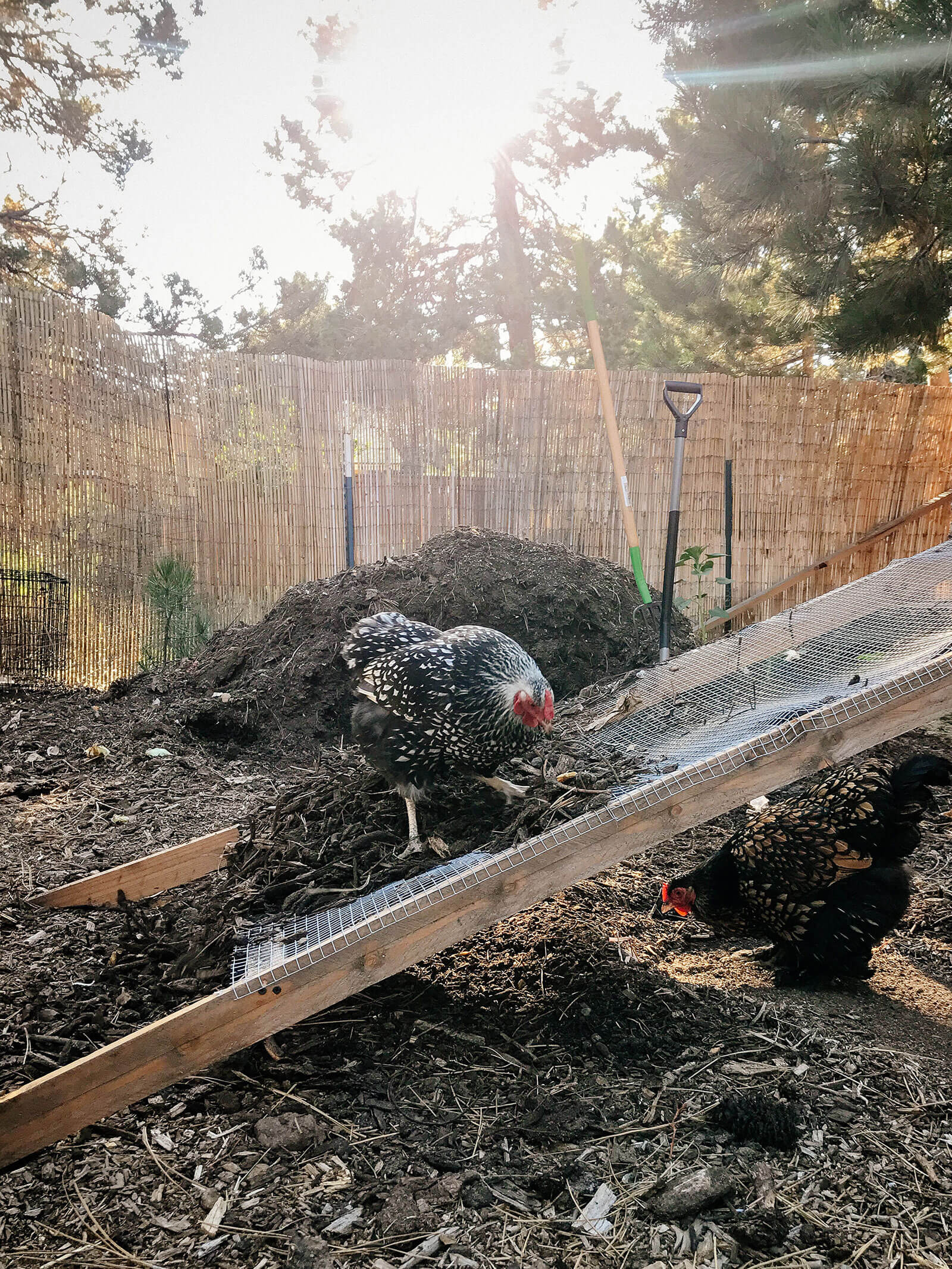
The chickens will eat what they want, shred up your scraps for quicker composting, and keep themselves busy and entertained on days they can’t free-range (which means less hen pecking among the flock).
After a few weeks, you’ll be so used to seeing orange yolks (the way most of us have been conditioned to see yellow yolks) that you might even think they haven’t changed in color.
Buy some eggs from the store and crack them into a bowl with your homegrown eggs—you’ll be stunned at the difference!
This post updated from an article that originally appeared on March 7, 2013.
View the Web Story on how to make chickens’ egg yolks darker.


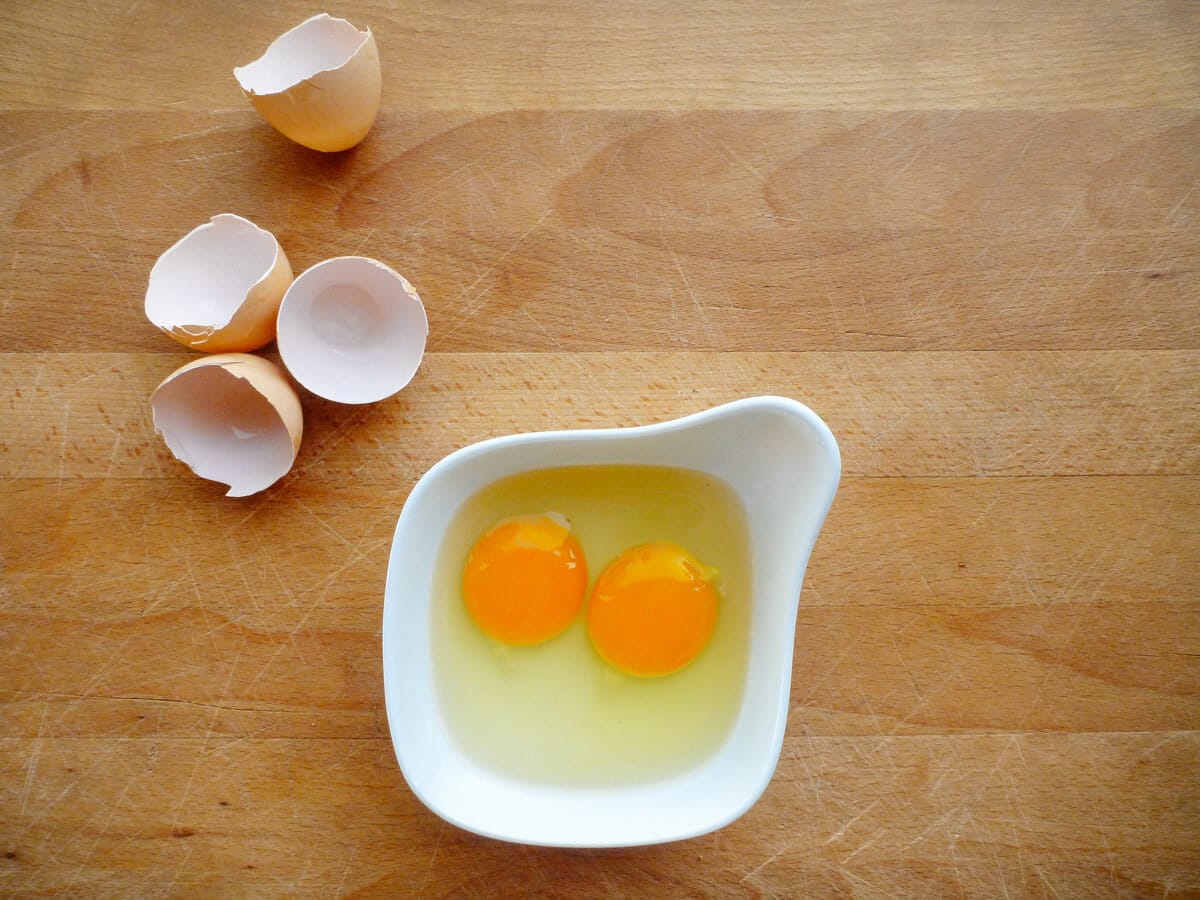













I am grateful for the research work and comments posted.
I’m a new poultry keeper, living in Masaka, Uganda, and I’ve been trying to improve my in- door chicken yolk color but un successful. Let me try one of them .
Hi! I have been raising chickens for almost two years, they free range in our ranch in TX, get first picks of all our kitchen and garden scraps, and I feed them whole grains and ferment goodies for them. I’d say they’re healthy an hippy chicks all the way, and they don’t produce dark orange yolks. I suppose the coloring could be subjective, or perhaps I haven’t cracked a store bought egg in a whole, but they just don’t look like the fancy rich colored egg yolks I see. The special carotenoid is interesting though, and the flame yolks too! Thanks toe post.
sos im on my way to buena vista michoacan soon cant waight to hear from you again to stay in touch growing tomatoes and chickens later.
I was skeptical reading your write up. Because I thought, here we go again, another blog that will associate orange yolks to organic feeding. But as I read through the blog, It is backed up by research. As an animal nutritionist, I loved the blog. It is true that whatever the chickens eat will affect the color of the yolk. Thank you for explaining it in a way that everyone can understand.
We saw this colour change when we got our first hens – 3 Isa Brown hens – and they were free range in our back yard that had plenty of insects, grubs and lush green grass (and weeds). My son returned home from visiting his father and the first time he went to use the freshly laid eggs he called me over and asked if our 2 day old eggs were rotten because of their dark golden orange colour. There is an amazing difference in the colour of hens on a correct natural diet and those that are not. We live in Australia and are currently in a drought and the lack of growth of everything green is showing up in our paler coloured eggs. Praying for rain to replenish the earth and put out the fires over here.
My best to you in Australia! Having lived in a state (California) that had severe drought for several years, as well as massive wildfires every season, I know the pain you’re going through. Doing a rain dance for you and hope for the return of greener pastures soon!
When I went to Australia all the eggs I bought from stores or restaurants all had bright orange Yolk. I did not see yellow once. Our egg industry obviously cuts a lot of corners.
It’s a real shame!
Viva la bold orange yolks…happy foraging feathered friends!
Once, my neighbour’s chook got into my garden, and as I tried to catch her, I crashed through a spider’s web. I was sorry but didn’t worry, because I thought it would soon make another – but the chook saw the spider, and gobbled it up instantly. Nice to know what goes into your free-range egg!
This story made me smile. 🙂
Actually it has been scientifically proven that most darker egg yolk has much more nutritional benefits. Including much more cholesterol which has been scientifically proven to be very necessary for the human brain and other health benefits! Please note that it has been scientifically proven that when humans eat food that is high in cholesterol it has no effect on blood cholesterol levels!
Hydrogenated or partially hydrogenated oils are used in many food products as a preservative and it is killing people! The best thing that came out of the Obama administration was to attempt to force the FDA to get that stuff out of our foods. Please get hydrogenated and partially-hydrogenated oils and other food products that contain them out of your diet! Most breads, cake mixes, and ready to eat products sold in a supermarket has it as an ingredient. It has been scientifically proven to cause hardening of the arteries (which is the leading cause of high blood pressure). It also directly damages the heart and may be the leading cause of heart failure! The most interesting fact about it is that if there is any amount in a food product or oil the health risks are the same (because it disables your body from being able to properly process animal fats), many of which are healthy fats!
I know these things from tons of research and experiences over the last 10 years.
Your absolutely right!!!
As,soon as someone says “scientifically proven” you know ypu better check it…it’s usually bull. In this case the post is a bit fanatical and mostly incorrect.
If you’re not bothered by cussing, NUTRITIONIST Bart Kay has a couple of channels on youtube and he gives/cites specific studies on the subject of cholesterol, etc. Since you want the real data. The short of it is, Bart Kay agrees with what Mark posted and backs it up with the studies that have been done.
If you’re not bothered by cussing, NUTRITIONIST ——
“LOUD NOISES–“
https://www.ncbi.nlm.nih.gov/pmc/articles/PMC6470839/
Eggs are healthy.
You are spot on with your assessment. Studies have proven what we thought just 10 or 15 years ago was incorrect about fats and cholesterol. The most recent studies do agree with you.
Thank you for your kind thoughts and beliefs. Having read many journals and articles about yellow vs orange yolks, I am not sure I concur with all your comments as it’s down to their diet, as you rightly say, but the flavour and nutritional values in my humble opinion isn’t that different. That being said the only way to truly evaluate the nutritional value is by sending the eggs to a lab for a proper analysis.
I know people say about eggs and vegetables, sweeter must be better… but that is purely an opinion not a scientifically proven fact.
I work on a school farm and only feed our “ladies” the best possible feeds with no GMO’s… I arrive at 7am every morning I work (3 days a week) to let them out to forage all day to their hearts content. On weekends one of the teachers lets them out. They eat bugs, weeds/herbs likes sorrel and dock (I like both myself), wild oats, worms and you’re right and they don’t have to be “out in the boonies”, they all ganged up on a mouse and killed it and well… you know the rest.
What you’ve helped me finally decide on is to get some cash from the school and grow some sprouts to add depth and culinary colour to
their diet. Thanks for writing a great post. Greetings from Australia!
True, flavor is subjective and most people don’t eat plain eggs by themselves anyway. I agree that nutritional value can’t be measured without lab analysis, but you can probably assume your pastured eggs are higher in vitamins (in comparison to conventionally raised eggs) based on the scientific studies already performed. I think sprouts are a great addition to their diet. Your flock is very lucky!
I totally agree in everything you said. I experienced the best tasting egg in the world (pls don’t make me list down the countries I’ve been and tasted eggs from each one of them.) It was in Papua New Guinea. Their backyard chickens are the Papuans’ source of income for the most part. Operational costs are close to nothing because they don’t have the cash to buy commercial feeds. But it is not a problem for them because theirs’ is a country rich in rainfall all throughout the year and therefore rich flora and fauna abounds. The chickens indulge in a buffet of earthworms, insects and bugs in a huge green fresh salad bowl.
I used to pet my grandpa’s chickens
Sweet
Wow!!! How cool and how interesting– seaweed for the chicks—yummy eggs I bet
While visiting Ireland last year for a month, I encountered a woman gathering seaweed on a rather deserted beach. She explained that not only was seaweed great in the bath, but feeding dried seaweed to her chickens produced bright orange yolks!
Wow!!! How cool and how interesting– seaweed for the chicks—yummy eggs I bet!
Seaweed is full of trace minerals that are very good for chickens. I add kelp granules to my custom-made chicken feed for this reason: http://gardenbetty.com/2013/04/homemade-whole-grain-chicken-feed-updated-and-now-corn-free/
While in Ireland for a month last year I encountered a woman on a rather deserted beach collecting seaweed. show explained that not only was it nice to bathe in, but when dried and fed to her chickens the yolks were very orange.
Oh Linda, I remember those orange yolks! I grew up in Taiwan, and when you get eggs from the yard, when you crack them open, the yolks are orange. They taste soooo much better than the eggs you can get here. Mom used to say that the “egg fragrance” is soooo enticing (scrambled eggs), that when we moved here to the US she said the eggs here stink when scrambled. *sigh*
Our chickens roamed in the backyard (we had 12 hens and 1 rooster), they didn’t even live in a coop. I remember as a kid, watching them all “fly” up a bush that’s only a feet or two off the ground, and sit in a ring around the center trunk; that’s how they slept at night. Our dog was always on the watch, and the birds all know they are safe. The chickens kept our yard free of insects, centipedes, bugs, and baby snakes!
That’s so idyllic to have chickens freely ranging a yard with no coop!
…and it is until after a few years of it. Hated to- wanted them to gain all the carotenoids they could obtain by the percentage of grass in their diet but after years of not being able to keep them out of my flower beds, I elected to have them live in a coop area now. Supplement with hanging fresh greens chopped out of my garden and use deep bedding to provide them with daily scratching fun.
Now my flower bed is beautiful once again. Miss the free ranging in the yard but they can be so destructive on flower beds/-lol took its toll on this ol boy- lol
LOL I know how you feel. I let my chickens roam the entire yard for over a year until they became too destructive on my vegetable beds. Now, a gate separates the “nice yard” from the “chicken yard” – still a large amount of space for them to play, but with hardier plants and trees that they can’t kill.
Thank you. I bought a couple of cartons of brown eggs from a brand I don’t usually buy and the yolks were a much deeper orange than I expected. I have seen yolks that are more orange than the usual store-bought yellow, but these were really deep orange. At first I thought that maybe they were bad but I found this site. I cracked em open, no smell and so I went ahead and cooked and ate em. And they had a nice rich flavor to them.
I read that Purina Layena feed (Tractor Supply $15 a bag) will give the yoke a nice deep orange color. Might be easier and cheaper than trying all the vegetables.
Purine Layena has marigold extract in it to produce dark yolks. Marigolds are a source of xanthophylls, which I discuss in this post. For people mixing their own feed or using another commercial feed, the greens suggested are a great way to go (plus they offer additional nutrients).
I put a bundle of kale leaves, few bundles of broccoli leaves, a couple bundles of spinach, and some collard greens in their coop yesterday and this morning all the greens were gone:-)
Yay!
Thanks Linda!
I got all the ingredients ordered and I’ve also started to give them the greens you mentioned like Kale, spinach, collard greens, broccoli leaves. They are not very enthusiastic about them at all. They kind of just kick them around and not eating them. Any ideas on how to make them eat the greens?
Also, I live in a city where they have limited space and time to roam and free range so I am thinking about buying live mealworms…will that be sufficient enough? Dried mealworms will do the same trick?
Please advice! I didn’t realize how unhealthy my hens were until I read your article about the orange yolk. I’ve fed them organic scratch feed since they were young so I will take any advice I can get from you to get the orange and healthy egg 🙂 Thanks Linda!
If your chickens have never been fed greens before, it might take them a little while to get used to them. I started by holding a few leaves and feeding them by hand when they were pullets. Soon they started foraging on their own and eating everything green in sight! Live mealworms and dried mealworms are both fine, though I use the latter because it’s less maintenance.
Celestine, I would suggest bunching the cut leaves and tying the stalks together. Hang them about the height of the chickens from a fence in the coop, post orb whatever. They prefer to pluck those greens that are hanging much better than when just lying on the ground. You’ll watch them just devour them this way, in short order.
Yep!
Good eggs are hard to find for those without hens (not allowed to have them here). I remember the orange yolks from the birds in the country. When using in recipes had to use half the amount stated because of the sticky yolks.
Wow, interesting!
I bought some eggs recently where the yolks were red. I don’t mean really golden, but red. They tasted fine, but I was concerned. The lady said maybe they got into the dog food that may have had red dye. It’s winter and they just started laying again after a few months of not laying. Any ideas?
It sounds bizarre, but feed does affect the color of the yolk. It’s possible those chickens may have binged on something super red… maybe berries, beets, or I guess red-dyed dog food. If the eggs had no smell and tasted fine, I wouldn’t be concerned unless you continually get red yolks from the eggs you buy… then something might be amiss with that flock.